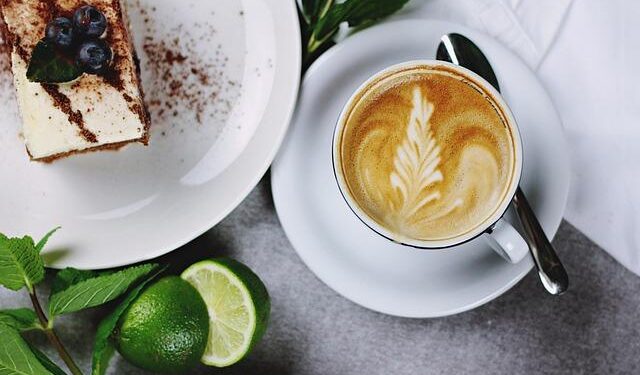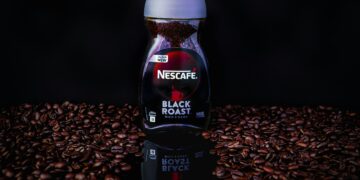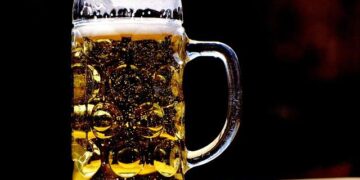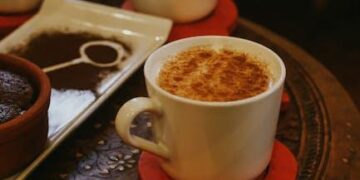Table of Contents
Introduction: The Call of the Wild and the Perfect Brew
Imagine waking to the crisp morning air, the scent of pine, and the promise of adventure.
What could make this moment even better? A perfect cup of coffee, of course.
But not just any coffee – a smooth, invigorating cold brew, perfectly suited for the great outdoors.
The concept of “Campout Cold Brew” encompasses both a popular, nostalgic drink from Dutch Bros and the broader, highly practical method of enjoying cold brew coffee while camping or on any outdoor adventure.
It is about bringing the comfort and quality of a cherished coffee ritual into the wilderness, effortlessly.
Decoding Dutch Bros’ Campout Cold Brew: A Sweet Escape
The Iced Campout Cold Brew from Dutch Bros represents a delightful blend designed to evoke nostalgic outdoor memories.
This beverage combines Dutch Bros’ signature Cold Brew with rich chocolate milk and a distinctive toasted marshmallow flavor.1
To complete the experience, it is crowned with their creamy Soft Top and a decadent chocolate drizzle, creating a sweet and comforting beverage.
Customers could opt for either regular or nitro-infused cold brew.1
For those who preferred a blended treat, Dutch Bros also offered the Campout Mocha Freeze.
This coffee-based blended drink featured roasted s’mores flavors, similarly topped with Soft Top and chocolate drizzle.1
While these were beloved offerings, the Iced Campout Cold Brew and Campout Mocha Freeze were seasonal, available only from July through the end of August in 2021.1
The creation of the Campout Cold Brew was directly inspired by a surge in enthusiasm for outdoor activities observed in recent years.
As an Oregon-based company, Dutch Bros embraced their affinity for spending time in nature, aiming to craft a nostalgic drink that perfectly matched the spirit of outdoor adventures.1
The seasonal nature of Dutch Bros’ Campout Cold Brew created a strong consumer desire that persisted beyond its official availability.
This is evident in the circulation of DIY recipes, such as one suggesting the use of chocolate macadamia nut and vanilla pumps, cold brew, chocolate milk, and a creamy soft top to replicate the flavor profile at home.2
This phenomenon illustrates how popular, limited-edition items can cultivate a demand that outlives their retail presence, fostering a vibrant home-brewing culture where consumers actively seek to extend the enjoyment of a particular flavor experience.
Why Cold Brew is Your Ultimate Camping Companion
Cold brew coffee offers a compelling array of advantages that make it an exceptional choice for outdoor excursions, extending far beyond mere convenience.
Key Advantages for Outdoor Adventures
One of the most significant benefits for camping is that cold brew requires no stove or fire for preparation.3
This attribute is incredibly useful in situations where campfires are banned due to fire risk, or when the goal is to minimize gear and pack light, simplifying the overall camping setup.3
Furthermore, cold brew can be prepared at home before a trip even begins, saving valuable time and effort at the campsite, especially on busy mornings when efficiency is key.3
Once prepared, cold brew concentrate boasts an impressive shelf life, remaining fresh for up to two weeks when properly kept cold in a cooler.3
This extended freshness means adventurers can enjoy quality coffee throughout an extended trip without the daily ritual of brewing.
Cold brew is also remarkably versatile.
It can be enjoyed chilled on hot days, providing a refreshing pick-me-up, or gently warmed up when the weather turns chilly, offering a comforting hot beverage.3
A particularly valuable characteristic for outdoor enthusiasts is cold brew’s naturally lower acidity compared to coffee brewed with hot water.3
Hot water extracts more acidity from coffee grounds, which can sometimes lead to stomach discomfort for sensitive individuals.8
Because cold brew is brewed cold or at room temperature, it tends to be less acidic, making it gentler on the stomach.8
This ease on the digestive system can be a significant advantage when individuals are active outdoors, as digestive comfort is paramount for maintaining energy and focus without gastrointestinal distractions.3
This direct connection between the brewing method’s chemical properties and its practical benefit for physical activity highlights how cold brew supports overall well-being in the field.
General Health and Environmental Benefits of Cold Brew
Beyond its convenience for camping, cold brew offers several notable health advantages.
Its caffeine content can improve mental acuity, enhance focus, and boost overall energy.8
This feeling of wakefulness is supported by scientific understanding: caffeine binds to adenosine receptors, which increases the absorption of dopamine and decreases the effectiveness of adenosine, a neurotransmitter that builds up throughout the day and causes sleepiness.8
This mechanism also contributes to a positive mood by stimulating the brain’s reward and motivation centers.8
Cold brew also provides abundant antioxidants, which are compounds that can help reduce the risk of various health issues, including certain types of cancer.8
The caffeine in cold brew can also act as a natural appetite suppressant, delaying feelings of hunger for a short period.8
Additionally, caffeine triggers a natural increase in epinephrine and norepinephrine, hormones that boost metabolism, leading to the breakdown of stored fat for energy.8
These combined benefits, ranging from a reduced risk of diabetes and heart disease to improved mental health, can contribute to a longer, healthier life.8
From an environmental perspective, making cold brew at home can significantly reduce plastic waste associated with store-bought iced coffee.9
It also encourages the use of reusable filters instead of disposable paper ones and allows for the composting of used coffee grounds.9
Furthermore, preparing large batches of cold brew can save energy compared to brewing hot coffee daily.9
The physiological advantages of cold brew’s caffeine and antioxidant content extend beyond mere convenience for outdoor activities.
The increased mental acuity and energy provided by caffeine are crucial for navigation, decision-making, and sustained physical effort on trails or during other demanding outdoor pursuits.8
The boost in adrenaline and noradrenaline can genuinely aid physical endurance and strength, which is invaluable during long hikes or climbs.8
The benefit of easing stomach issues is also particularly critical in remote settings where discomfort can significantly impact the experience.3
Thus, cold brew functions not just as a refreshing beverage but as a performance and wellness aid that actively supports the physical and mental demands of outdoor adventures, contributing to a more enjoyable and safer experience.
Mastering DIY Cold Brew for the Great Outdoors
Making cold brew coffee at home is a straightforward process that yields a smooth, less acidic concentrate perfect for camping.
The Fundamental Cold Brew Process (Immersion Method)
Cold brew coffee is fundamentally simple: it is made by soaking coarsely ground coffee in cold or room temperature water for an extended period, typically 12 to 24 hours.4
This slow infusion extracts flavor without the bitterness often associated with hot brewing.9
The immersion method is the most common and straightforward approach.
To begin, combine coffee grounds and water in a container, stir gently to ensure all grounds are saturated, cover it, and let it steep.7
After the steeping period, the mixture is strained through a fine-mesh strainer or cheesecloth to separate the concentrate from the grounds.7
While other methods like slow drip exist, they often require specialized equipment that is less suitable for portability in an outdoor setting.9
Essential Ingredients and Ratios for Concentrates
The core ingredients for cold brew are coarsely ground coffee and cold or room temperature water.7
For a strong cold brew concentrate, a common starting point is a 1:4 coffee to water ratio by weight (e.g., 1 cup or 113 grams of coarsely ground coffee to 4 cups or 907 grams of water).4
This concentrate is typically diluted before consumption.
For a ready-to-drink cold brew, a 1:8 coffee to water ratio by weight is suggested.9
Experimentation with these ratios is encouraged to find the preferred strength and flavor profile.7
Tips for Success: Grind Size, Water Quality, Steep Time, and Temperature
Several factors contribute to a successful cold brew:
- Grind Size: This is crucial. Use a coarse grind, similar to coarse cornmeal or sea salt, or what would be used for a French press.7 A fine grind can lead to over-extraction, bitterness, and a gritty, muddy brew that is difficult to filter.7
- Freshness: For the best flavor, grinding beans just before brewing is recommended.9
- Water Quality: Always use filtered water for the cleanest, sweetest taste.7
- Steep Time: The ideal steep time ranges from 12 to 18 hours.4 Steeping for less than 12 hours can result in a weak, watery brew, while exceeding 24 hours can lead to over-extraction and bitterness.9
- Temperature: Brewing at room temperature for 12-14 hours can shorten the steep time, while brewing in the refrigerator typically requires 16-18 hours.4 Room temperature brewing generally leads to faster extraction.9 Understanding the relationship between brewing temperature and steep time is vital for campers. Brewing at room temperature significantly shortens the required steeping duration (12-14 hours), making overnight preparation feasible without constant refrigeration.14 This allows adventurers to wake up to a ready-to-drink coffee, streamlining morning routines in outdoor settings where traditional refrigeration might be limited.
- Initial Stir: Stir the grounds and water thoroughly at the start to ensure even saturation and extraction.7
- Filtration: After the initial straining, a second filtration through a paper coffee filter can result in a smoother, less cloudy brew.9
- Optional Add-ins: Experiment with vanilla extract, cinnamon sticks, or cocoa nibs during brewing for flavored cold brew.9
Troubleshooting Common Issues
Common problems encountered during cold brew preparation and their solutions include:
- Too Weak: Increase the coffee-to-water ratio or steep for a longer duration within the recommended range.9
- Too Strong: Dilute with more water or milk before drinking, or use less coffee in the next batch.9
- Too Bitter: Use a coarser grind or shorten the steep time.9
- Cloudy Brew: Perform a second filtration using a finer filter, such as a paper coffee filter.9
DIY Cold Brew Ratios & Steep Times
For those looking to craft their own cold brew, the following table provides a concise guide to common ratios and recommended steep times, considering different desired concentrations and brewing environments.
| Concentration Type | Coffee-to-Water Ratio (by weight) | Example Quantity (Approx.) | Recommended Steep Time (Room Temp) | Recommended Steep Time (Refrigerated) | Dilution Guidance |
| Concentrate | 1:4 | 1 cup coffee to 4 cups water | 12-14 hours | 16-18 hours | Dilute 1:1 to 1:2 with water/milk |
| Ready-to-Drink | 1:8 | 1 cup coffee to 8 cups water | 12-14 hours | 16-18 hours | Drink as is or with minimal dilution |
Your Essential Camp Coffee Kit: Gear & Storage Solutions
Equipping for camp coffee involves selecting the right brewing tools and ensuring proper storage to maintain freshness and safety in the outdoors.
Portable Cold Brew Makers
While simple containers can suffice for immersion brewing 4, several specialized portable cold brew makers enhance the camping experience:
- Rumble Go: This innovative filter system transforms any compatible 16-32oz wide-mouth water bottle (such as Nalgene, Hydro Flask, Klean Kanteen, or CamelBak) into a cold brew maker.16 It features an 18/8 stainless steel filter with 200-micron holes for ideal steeping and an FDA-approved silicone cap that ensures an airtight, leakproof brew, preventing oxidation. Its extendable base fits various bottle heights, and it requires no plastic parts or disposable filters.16
- Asobu Cold Brew Coffee Maker: This option includes an integrated microfine stainless steel mesh strainer and a 32oz insulated carafe, designed to keep cold brew chilled for hours. It offers a complete, self-contained brewing and storage solution.17
- MiiR Stainless Steel Cold Brew Filter: Designed to fit MiiR’s 32oz Wide Mouth water bottles, this filter features precision micro-perforations for smooth cold coffee with minimal sediment. It has a fold-down handle for easy use and cleaning.18 While compact and durable, some users note the strainer takes up significant space, yielding less cold brew, and it may leave a small amount of fine sediment.18
Alternative Brewing Methods for Camping
For those prioritizing ultimate simplicity or specific needs, other no-heat or minimal-heat options exist:
- Brew Bags / Coffee Pouches: Similar to tea bags, these contain coffee grounds and can be steeped in cold water overnight.11 They offer a smoother taste than instant coffee and can even steep in a water bladder while hiking.19
- Instant Coffee: The simplest no-heat method, instant coffee dissolves in cold or room-temperature water.3 Modern brands offer improved taste, making it a convenient, lightweight choice for quick caffeine fixes.3
- Pre-made Cold Brew Concentrates: For ultimate convenience, pre-packaged cold brew concentrates eliminate the need for any brewing equipment. Products like Bellmott’s concentrate are budget-friendly, ready in seconds (just add water or milk), and perfect for remote locations, offering barista-quality coffee on the go.20
- French Press: While typically used for hot coffee, a French press can also be used for cold brew by steeping grounds overnight and then pressing to separate.7
The array of portable cold brew solutions, ranging from dedicated makers to simple DIY methods and pre-made concentrates, highlights a clear trade-off between convenience and quality.
Dedicated makers tend to offer more refined filtration and insulation, while simpler DIY methods prioritize lightness and adaptability.
Pre-made concentrates represent the peak of convenience, sacrificing the brewing experience for instant gratification.
This spectrum illustrates that the ideal choice depends entirely on the camper’s specific priorities, such as weight constraints, ease of use, desired brew quality, or immediate access to coffee.
Smart Storage for Coffee Grounds and Prepared Cold Brew
Proper storage is key to maintaining freshness and preventing spoilage, especially in the variable outdoor environment.
For Coffee Grounds/Beans:
- Airtight Containers: Stainless steel vacuum-sealed canisters (e.g., Fellow Atmos), glass jars with rubber-sealed lids (for car camping), or plastic food storage containers with locking lids are excellent for preventing exposure to oxygen and moisture, thereby preserving flavor.21
- Resealable Bags: Foil-lined coffee bags with one-way valves, silicone bags, or dry bags are lightweight, waterproof, and effective for keeping moisture out, particularly for backpacking.21
- Pre-Portioned Packs: DIY snack-size bags or vacuum-sealed single-serving pouches ensure the right amount for each cup and help maintain freshness.21
For Prepared Cold Brew (Concentrate):
- Insulated Flasks or Thermoses: These are ideal for storing pre-brewed cold brew, keeping it chilled for hours or even days. The Stanley Classic Vacuum Bottle is noted for keeping coffee hot for 12+ hours, implying similar performance for cold beverages.21
- Sealed Containers: Cold brew concentrate should be stored in a leak-proof bottle or airtight glass container in the refrigerator (or cooler) to maximize its shelf life (up to two weeks for concentrate).3
- Dilution Strategy: To extend shelf life, it is crucial to store cold brew as a concentrate and dilute it with water or milk only when serving.5 Adding additives like milk or sugar significantly reduces its freshness to 2-3 days.5
- Temperature Control: Keeping cold brew at 41°F (5°C) or below is critical to prevent the growth of harmful bacteria and slow the process of oxidation.5 This is a particular challenge in camping, where maintaining consistent cold temperatures in a cooler can be difficult as ice melts and external temperatures fluctuate. Therefore, storing cold brew as a concentrate becomes paramount. This practice not only extends the shelf life, reducing waste and ensuring availability, but also minimizes the risk of spoilage and potential health issues from bacterial growth, which is a higher concern in remote environments.
- Pre-bottling: For convenience and to maintain freshness, pre-portioning cold brew into smaller, sealed bottles before a trip is advisable.3
- Fresh Grind: If possible, grinding coffee beans just before brewing yields the freshest flavor, although pre-grinding is often a necessary compromise for camping convenience.9
- Avoid Direct Sunlight/Heat: Store coffee grounds and brewed cold brew away from direct sunlight and heat sources, as these can degrade flavor.21
- Reusable Grounds: For multi-day trips, coffee grounds can be reused by adding fresh mix each night to strengthen the cold brew. It is best to store grounds in the same container to avoid spills.4
Wildlife Safety: In bear country, coffee’s strong aroma can attract animals.
It is essential to store coffee (grounds or brewed) in bear-proof canisters or odor-proof bags (like Loksak OPSAK) to contain scents and prevent unwanted encounters.21
Camping Cold Brew Gear Comparison
Choosing the right gear for camp cold brew involves balancing portability, ease of use, and desired brew quality.
The table below offers a comparison of common options:
| Gear Type | Specific Examples | Key Features | Pros | Cons | Best For |
| Portable Maker | Rumble Go, Asobu Cold Brew Maker, MiiR Cold Brew Filter | Integrated filter, Airtight seal, Insulation (Asobu), Universal fit (Rumble Go) | High quality, Compact, Designed for cold brew, Less mess | Can take up space, May leave some sediment (MiiR), Initial cost | Car camping, Short backpacking trips, Quality-focused campers |
| Brew Bags / Coffee Pouches | Maxwell House coffee bags, Wildland Coffee Brew Bags | Pre-portioned grounds in a bag, Steep in water | Lightweight, Simple, No equipment needed, Cleaner than loose grounds | May have sediment, Less control over strength, Can be weaker than concentrate | Ultralight backpacking, Quick trips, Simplicity seekers |
| Pre-made Concentrate | Bellmott Cold Brew Concentrate | Ready-to-drink (dilute), No brewing required | Ultimate convenience, Instant, Barista quality, Budget-friendly per serving | No brewing experience, Less control over bean choice | Any camping style, Remote locations, Time-saving, Instant gratification |
| French Press | Standard French Press | Plunger for separation | Familiar method, Can make hot or cold brew | Can be bulky, Requires cleaning, Less efficient for cold brew than dedicated methods | Car camping, Glamping, Those who already own one |
Water Purification Considerations for Backcountry Brewing
Making cold brew requires a significant amount of clean water.4
In the backcountry, access to potable water is not guaranteed, making water purification a critical prerequisite for safe and palatable cold brew.
Various methods are available for treating water in the wilderness:
- Pump Purifiers: These devices allow for precise processing of the exact amount of water needed.22
- Gravity Filters: These systems conveniently filter water using gravity, requiring less manual effort once set up.22
- UV Light Purifiers: Pen-style devices that use ultraviolet light to treat water quickly and easily, though they require batteries and may be less effective with silty or cloudy water, necessitating prefiltration.22
- Bottle Filters: These offer fill-and-sip simplicity, integrating filtration directly into a water bottle.22
Regardless of the chosen method, considering a prefilter to remove large particles can significantly improve the effectiveness of any purification process.22
For backcountry cold brew, the water purification process is not just a general camping safety measure but an essential, integrated first step in the brewing process.
Without it, the cold brew would be unsafe to drink, regardless of how well it is brewed.
This highlights the need for campers to plan their water sourcing and purification alongside their coffee brewing, making it an integrated water management strategy for their cold brew needs.
Beyond the Brew: Enhancing Your Outdoor Coffee Experience
Once the cold brew is prepared, there are several ways to enjoy and preserve its quality in the great outdoors.
Creative Serving Suggestions
Cold brew offers versatility in how it can be served:
- Iced: The most common way to enjoy cold brew is simply by pouring it over ice.5 For an undiluted experience, making coffee ice cubes from leftover cold brew can be an excellent strategy.5
- Warmed: Despite its name, cold brew can be gently warmed in a microwave or over a stove for a hot cup, particularly appealing on chilly mornings.3
- Dilution: Cold brew concentrate should always be diluted to the preferred strength with water or milk.3 A common starting point is 1 part concentrate to 1-2 parts water or milk, but this can be adjusted to taste.3
- Additives: Enhance flavor with milk, cream, sugar, or other syrups.5 However, it is important to add these only when serving to maintain the cold brew’s shelf life.5
- Creative Mixes: Cold brew concentrate can be used as a base for camping-friendly variations of mixed coffee drinks, such as an “Espresso Martini”.20
Tips for Maximizing Freshness and Flavor on the Trail
Maintaining the quality of cold brew in an outdoor setting requires strategic planning:
- Store as Concentrate: Keep cold brew in its concentrated form until it is ready for consumption.5 Diluting it prematurely, especially with milk or sugar, drastically reduces its shelf life.5
- Airtight & Cold Storage: Always store prepared cold brew in an airtight container (glass is preferred over plastic for flavor preservation) and keep it chilled in a cooler at or below 41°F (5°C).3
- Pre-bottling: For convenience and to maintain freshness, pre-portioning cold brew into smaller, sealed bottles before a trip is recommended.3
- Fresh Grind: If feasible, grinding coffee beans just before brewing yields the freshest flavor, though pre-grinding is often a necessary compromise for camping convenience.9
- Avoid Direct Sunlight/Heat: Store coffee grounds and brewed cold brew away from direct sunlight and heat sources, which can degrade flavor.21
- Reusable Grounds: For multi-day trips, coffee grounds can be reused by adding fresh mix each night to strengthen the cold brew.4 It is advisable to store grounds in the same container to avoid spills.4
Conclusion: Sip, Savor, and Explore
Cold brew coffee truly shines in the outdoors, offering unparalleled convenience with no need for heat, an impressive shelf life, and a naturally smoother, less acidic taste that is gentle on the stomach.
Beyond mere refreshment, its energizing and mood-boosting properties make it a functional companion for any adventure.
Whether one opts for a convenient pre-made concentrate, a clever portable brewing device, or a simple DIY overnight steep, integrating cold brew into a camping routine elevates the experience.
It is about savoring those quiet moments in nature, fueled by a perfect brew, and making every outdoor escape a little sweeter.
Therefore, adventurers are encouraged to pack their gear, choose their preferred method, and get ready to sip, savor, and explore the vastness of the outdoors.
Works cited
- DUTCH BROS CREATES THIS SUMMER’S SWEET ESCAPES, accessed July 23, 2025, https://www.dutchbros.com/news-events/dutch-bros-creates-this-summers-sweet-escapes
- www.tiktok.com, accessed July 23, 2025, https://www.tiktok.com/@amberalejandrez/video/7121107081297595694?lang=en#:~:text=Learn%20how%20to%20make%20a,and%20a%20creamy%20soft%20top.
- How to Make Coffee While Camping Without Fire? – OutIn, accessed July 23, 2025, https://outin.com/blogs/news/camping-coffee-without-fire-techniques
- Backcountry Cold Brew Coffee | Adventure Dining Guide, accessed July 23, 2025, https://www.adventurediningguide.com/backcountry-cold-brew-coffee/
- How To Store Cold Brew Coffee So It Preserves For A Long Time – DarkHorseCoffeeCompany, accessed July 23, 2025, https://www.darkhorsecoffeecompany.com/blogs/coffee/how-to-store-cold-brew-coffee
- How Long Can You Keep Cold Brew Coffee in the Refrigerator? Experts Explain, accessed July 23, 2025, https://www.marthastewart.com/8146833/how-long-cold-brew-lasts-refrigerator-storage-tips
- How To Make Cold Brew Coffee – Simply Recipes, accessed July 23, 2025, https://www.simplyrecipes.com/recipes/how_to_make_cold_brew_coffee/
- 9 Health Benefits of Cold Brew Coffee – Based on Science, accessed July 23, 2025, https://cornercoffeestore.com/benefits-of-cold-brew-coffee/
- Mastering Home Cold Brew Coffee: Your Ultimate Guide – OutIn, accessed July 23, 2025, https://outin.com/blogs/news/home-cold-brew-coffee-mastery
- Mass-producing cold brew for a camping event. Any tips? : r/Coffee – Reddit, accessed July 23, 2025, https://www.reddit.com/r/Coffee/comments/8i69l7/massproducing_cold_brew_for_a_camping_event_any/
- Trail Cold Brew Coffee : r/CampingandHiking – Reddit, accessed July 23, 2025, https://www.reddit.com/r/CampingandHiking/comments/584qxo/trail_cold_brew_coffee/
- Best filter to use for cold brew? – Coffee Stack Exchange, accessed July 23, 2025, https://coffee.stackexchange.com/questions/2140/best-filter-to-use-for-cold-brew
- Making Camp Coffee, Cold Brew Coffee and how to brew it – Camp and Travel Australia, accessed July 23, 2025, https://campandtravel.com.au/making-camp-coffee/
- How Long to Steep Cold Brew (Expert Tips & FAQs) | Corner Coffee Store, accessed July 23, 2025, https://cornercoffeestore.com/how-long-to-steep-cold-brew/
- How To Cold Brew Coffee – Can Even Do At Camp! – Reuse Grow Enjoy, accessed July 23, 2025, https://reusegrowenjoy.com/how-to-cold-brew-coffee/
- Rumble Go: Portable Cold Brew Coffee Maker (filter only) – Rumble Jar, accessed July 23, 2025, https://therumblejar.com/products/rumble-go
- Copper Cold Brew Coffee Maker – ASOBU, accessed July 23, 2025, https://asobubottle.com/products/cold-brew
- Stainless Steel Cold Brew Filter – MiiR.com, accessed July 23, 2025, https://miir.com/products/stainless-steel-cold-brew-filter
- How to Make Coffee While Camping (10 Easy Methods), accessed July 23, 2025, https://cornercoffeestore.com/how-to-make-coffee-while-camping/
- Cold Brew Concentrate – Bellmott, accessed July 23, 2025, https://bellmott.com/products/cold-brew-concentrate
- How to Store Your Coffee for Maximum Freshness While Camping …, accessed July 23, 2025, https://aerialresupplycoffee.com/blogs/the-resupply-blog/how-to-store-your-coffee-for-maximum-freshness-while-camping
- How to Choose a Water Filter or Purifier – Backpacking – REI, accessed July 23, 2025, https://www.rei.com/learn/expert-advice/water-treatment-backcountry.html






